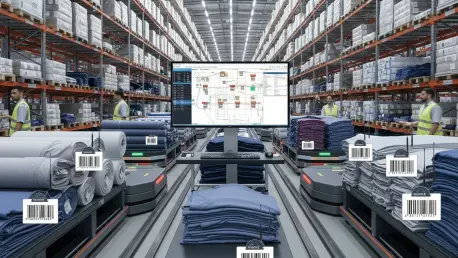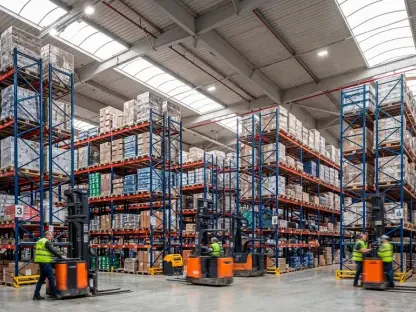Setting the Stage for RFID’s Impact
Imagine a global retail chain scrambling to manage a staggering 78% surge in textile item movement during the peak summer sales season, with over 513 million items in circulation within a single month, highlighting the immense pressure on supply chains. This scenario, drawn from real-world data, underscores the critical need for precision and speed in delivery. RFID (Radio Frequency Identification) technology has emerged as a linchpin in addressing these logistical challenges, transforming how the textile industry tracks, manages, and distributes products across international markets. This review delves into the core capabilities of RFID, exploring its role in revolutionizing textile logistics amid rising consumer demand.
The significance of RFID extends beyond mere tracking; it represents a cornerstone of digital transformation in supply chain management. By leveraging radio waves to capture data through tags, readers, and integrated software systems, this technology offers unprecedented visibility into complex operations. As the textile sector grapples with seasonal spikes and global distribution hurdles, RFID provides a robust solution to streamline processes and enhance responsiveness, setting the stage for a deeper analysis of its features and real-world applications.
Unpacking RFID’s Key Features in Textile Logistics
Real-Time Tracking for Seamless Operations
RFID technology stands out for its ability to enable real-time tracking of textile products, from manufacturing floors to retail shelves. Each item or batch can be monitored with pinpoint accuracy through unique identifiers embedded in tags, allowing stakeholders to follow goods across vast supply chains. This capability proves invaluable during high-demand periods, ensuring that products reach their destinations without delay or loss, thus maintaining customer satisfaction.
Beyond basic tracking, RFID enhances traceability by providing detailed insights into product journeys. This level of visibility helps mitigate risks such as theft or misplacement, which are common in sprawling global networks. The precision offered by RFID systems translates into reduced operational disruptions, fostering trust among manufacturers, distributors, and retailers who rely on timely deliveries to meet market needs.
Streamlining Inventory and Warehouse Efficiency
Another critical strength of RFID lies in its transformation of inventory and warehouse management. Automated scanning eliminates the need for manual counts, drastically cutting down on human error while speeding up stock assessments. This efficiency ensures that warehouses can maintain optimal inventory levels, avoiding overstocking or shortages even during peak sales seasons.
The technology also facilitates smoother warehouse operations by integrating data collection with management systems. Such integration allows for rapid updates on stock status, enabling quick decision-making to replenish or redirect resources as needed. For retail chains handling millions of items, this streamlined approach is essential to keep pace with consumer demand and maintain operational fluidity.
Performance and Real-World Applications
Adapting to Seasonal Demand Surges
RFID’s performance shines brightest during intense periods like summer sales, where supply chains face exponential increases in activity. Data highlights a remarkable 62% rise in scanned boxes—totaling 2.6 million—and a 14% monthly uptick in tracked items during these peak times. Such metrics demonstrate RFID’s capacity to handle massive volumes without compromising accuracy or speed, ensuring products are available where and when they are needed most.
Major international retail chains have adopted RFID to manage these seasonal fluctuations effectively. The technology supports omnichannel strategies by balancing in-store and online demand, allowing retailers to allocate inventory dynamically based on real-time data. This adaptability not only meets consumer expectations but also strengthens the resilience of global supply networks under pressure.
Innovative Use Cases and Industry Impact
Specific implementations of RFID reveal its versatility in addressing unique challenges within textile logistics. For instance, the technology aids in coordinating product flows across diverse markets, ensuring that items move efficiently from production hubs to retail outlets worldwide. This global responsiveness is critical for retailers aiming to capitalize on short sales windows and maintain competitive edges.
Additionally, RFID supports sustainability initiatives by optimizing resource use and reducing waste through precise tracking. By minimizing excess inventory and improving distribution accuracy, the technology aligns with industry goals to operate more responsibly. These diverse applications underscore RFID’s role as a transformative tool, reshaping how the textile sector navigates logistical complexities.
Challenges Hindering RFID Adoption
Technical Barriers to Implementation
Despite its advantages, RFID technology faces notable technical obstacles in textile logistics. Tag readability can be compromised in dense environments or when interfered with by materials like metal and liquids, which are often present in storage and transport settings. These issues can disrupt data capture, posing challenges to maintaining consistent tracking across operations.
Efforts to address these limitations include developing more robust tags and advanced reader systems designed to overcome environmental interference. While progress is evident, these solutions require ongoing refinement to ensure reliability in varied conditions. Overcoming such technical hurdles remains a priority for widespread adoption in the industry.
Market and Regulatory Constraints
Beyond technical issues, market and regulatory challenges also impede RFID integration. High initial costs for tags, readers, and system setup can deter smaller players from adopting the technology, limiting its reach across the sector. Balancing affordability with functionality is crucial to democratizing access to these tools.
Privacy concerns surrounding data collection further complicate deployment, as stakeholders must navigate strict regulations to protect consumer information. Developing secure protocols and cost-effective solutions is underway, but these barriers highlight the need for collaborative efforts between technology providers and industry leaders to foster trust and accessibility in RFID applications.
Looking Ahead: The Future of RFID in Textile Logistics
Technological Advancements on the Horizon
The evolution of RFID technology promises exciting developments for textile logistics in the coming years. Innovations such as tag miniaturization and improved energy efficiency are set to enhance deployment flexibility, allowing for broader use across diverse product lines. Integration with AI for predictive analytics also holds potential to anticipate demand trends and optimize supply chain planning.
These advancements aim to create fully automated systems capable of adapting to dynamic market conditions with minimal human intervention. As research and development progress from this year onward, the focus on scalability and efficiency will likely drive RFID’s role in shaping smarter, more responsive logistics frameworks for the textile industry.
Long-Term Industry Transformation
Looking further ahead, RFID is poised to redefine global retail by enabling seamless adaptability to consumer behavior and seasonal shifts. Its capacity to support sustainability through waste reduction and resource optimization aligns with growing environmental priorities, positioning it as a key player in responsible business practices. The technology’s impact could extend to creating supply chains that are not only efficient but also ethically sound.
The potential for RFID to integrate with other emerging technologies, such as IoT and cloud-based systems, suggests a future where data-driven insights become the norm. This convergence will likely empower retailers to navigate complexities with greater agility, ensuring they remain competitive in an ever-evolving marketplace.
Final Thoughts and Next Steps
Reflecting on this review, it is evident that RFID technology has proven itself as a game-changer in managing the intense demands of textile logistics, particularly during peak sales periods. The ability to track millions of items and boxes with precision has addressed critical pain points in supply chain efficiency, offering a clear path to operational success for many retail giants.
Moving forward, industry stakeholders should prioritize investments in overcoming technical and cost-related barriers to broaden RFID adoption. Collaborative initiatives to enhance data security and develop affordable solutions could accelerate integration, especially for smaller enterprises. Exploring partnerships with tech innovators to pilot AI and IoT integrations is also a promising step to unlock the full potential of RFID in transforming global textile supply chains.









